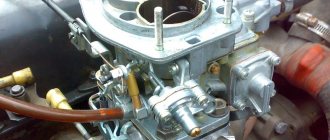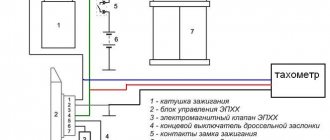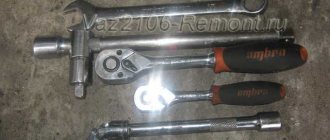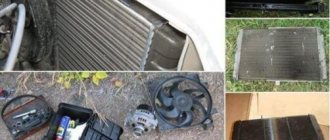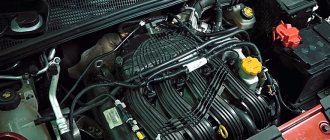This question is not often, but consistently asked by my readers and channel viewers - what is better than 8 or 16 valves in the engine block head? Many people believe that the 8-valve version is a thing of the past and spending your hard-earned money on it is, at the very least, stupid! But 16 is YES, IT IS! Others, on the contrary, insist that the 16 valve version is more expensive, more demanding to maintain, and if it breaks, “write it down”! But where is the truth, and what exactly is the difference between these two units, are they very different? I propose to weigh all the pros and cons, so there will be a video version...
You know, there are really a lot of battles on the Internet on this never-ending topic, but I think everyone here is right in their own way. After all, some expect reliability and simplicity, while others expect greater power and smooth operation. The tasks are different, and the engines are different, but let's take a closer look.
About the technical component
Technically, engines with 8 and 16 valves are quite different. Although all the difference is stored at the top (engine block head) where the car's camshafts (camshaft) are/are installed. In fact, this is the main design feature, but what I want to note is that almost every engine can be made into either an 8 or 16 valve version. For example, on our VAZs, the engines are very similar, and hypothetically, on the same block, you can fit a different cylinder head, with one or two camshafts.
Consumer characteristics
In addition to power and efficiency, the engine is evaluated in terms of repair and maintenance costs. The ability to improve the performance of the motor also increases its “value”. For example, to increase the engine displacement, the cylinders are bored or the piston stroke is increased.
Repair work
Any engine experiences high load during aggressive driving. Whether it's an 8 or 16 valve engine. Even with proper operation, the power unit has resource limitations. Many of the parts involved wear out and need to be replaced. Frequent problems:
- floating or high idle speed. During diagnostics, the mass air flow sensors, idle air control and throttle valve are checked;
- overheating of the engine may be due to a faulty thermostat, lack of coolant or contamination of the radiator;
- clogged injectors or old spark plugs can cause engine vibration;
- Electrical failures often occur on domestic engines;
- knocking noises under the hood indicate faulty hydraulic lifters, unadjusted pushers or a damaged connecting rod and piston group.
If the engine is equipped with push-in pistons, without grooves on the bottom, a broken timing belt causes the valve stems to bend. To avoid the problem, you need to install a high-quality belt and check its condition every 15,000 km. A safer option is to replace the pistons with non-stick ones.
A drop in compression or an increased appetite for oil is already a reason for a major overhaul, but in practice this happens after 200,000 km. The difference in the cost of major repairs of 8 and 16 valve VAZ engines is 5 - 10 thousand rubles. The average price for a complete overhaul is 8kl. — 35,000 rub.
Similar article Technical characteristics and maintenance of the 603 Mercedes engine
Tuning
Engines are tuned to achieve better performance, both 8 and 16 valve units. To achieve high-torque performance of the car, the engine displacement is “increased”:
- Bore the cylinders or increase their number.
- Increase piston stroke.
The most popular method is cylinder boring. However, cutting more than 3 mm from the original size may result in thinning of the walls. This reduces the service life of the part and leads to leaks.
Other tuning options:
- Increasing the number of valves.
- Installation of a sports camshaft for increased power and efficiency.
- Increasing the volume of the exhaust receiver to stabilize the engine.
- Replacing the air filter with a zero filter to increase the amount of incoming air.
- Turbocharged engine.
Main differences.
The 8-valve engine has a narrow cylinder head because it has a single camshaft. The candles are located on the block horizontally and at a certain angle. The camshaft controls the order of their opening - first it opens the intake, then the exhaust. The valve opens with the help of conical parts located on the camshaft, and closes with the help of springs located on it. In a four-cylinder engine, there are two valves for each cylinder of the engine - intake and exhaust. Actually, that’s why there are eight of them per power unit.
In a 16-valve engine, the cylinder head is wide in relation to the single-row four-cylinder block, since there are two camshafts on it. The design itself is complicated; the valves are adjusted using hydraulic compensators. Opening and closing have the same principle as in an 8-valve engine. The spark plugs in such engines are positioned strictly vertically, as if buried in the cylinder block cover. For each one engine cylinder there are already 4 valves - which means, respectively, 16 per engine. What if, instead of two small valves, we insert two larger valves... In principle, it is possible, but then the gas will fill the combustion chamber unevenly, and the engine will not operate as silently as we would like.
Advantages of an 8-valve engine:
- Initially, the design of the engine is relatively very simple and, accordingly, easy to maintain.
- The absence of hydraulic compensators undoubtedly simplifies the design of the power plant as a whole.
- Undemanding to oil.
Flaws:
- Power is less compared to a 16 valve engine. It is also impossible to achieve such high speeds - two valves per cylinder does not allow speeding up the intake and release of fuel and gases from the chamber. The process is happening slower than we would like.
- Increased fuel consumption. Due to the fact that the gas exits through one valve, which cannot let through more than it should.
- Such engines are, in essence, noisier, especially when moving at high speeds.
- The absence of hydraulic compensators requires adjustment of the valves as their precise synchronization is disrupted (even with slight deformation of the camshaft cam profile), in the worst case, a knocking sound appears.
16-valve engine and its significant advantages:
- More powerful. It accelerates better and therefore the top speed will be significantly higher than that of an 8-valve engine. More powerful. Accelerates better and therefore the top speed will be significantly higher than the 8-valve engine.
- It is also important that fuel consumption is noticeably less (should be).
- Engine noise is less.
- The valves are regulated by hydraulic compensators.
Flaws:
- The presence of hydraulic compensators requires a timely change of engine oil to avoid coking of the hydraulic compensators.
- Engine maintenance is more expensive. After all, the design of such an engine is an order of magnitude more complex than the design of an 8-valve engine.
A few words about another reason why valves should sit tightly in the seat. In addition to ensuring complete sealing of the combustion chamber, it should be taken into account that the valve discs operate under severe conditions of high heat. In addition, the plates must be in close contact with the seat, which is located on the cylinder head, which is cooled. After all, the heated plate transfers most of the heat to the saddle. This is especially true for the exhaust valve, since it is cooled only through the tight fit of the plate to the seat, and the intake valve is cooled when the incoming air-fuel mixture is in contact with the seat. If there is poor contact with the seat, no (even the most heat-resistant) valve will withstand such strong overheating. It will simply burn out and collapse, so its tight fit in the saddle is very important. Therefore, they are made from heat-resistant metal alloys. In addition, they do not have magnetic properties.
Economical
In terms of fuel consumption, a 16-valve engine differs from an 8-valve engine by being slightly more economical. Multi-valve heads fill and distribute the mixture better due to the versatile filling of the chamber. This design feature ensures economical operation. In addition, fast acceleration allows you to save fuel, which is consumed at high speeds.
In practice, consumption depends on driving style, type of fuel, tire pressure, curb weight and outside temperature.
Despite being economical in terms of fuel consumption, the 16 valve engine requires better oil and gasoline. If in an 8 valve you can get by with semi-synthetics or mineral water, in a 16 valve it is permissible to use only synthetics.
Similar article Technical characteristics of the Moskvich 412 engine
8 valve engine
This is indeed an archaic, but nevertheless reliable, simple and cheap to repair scheme. New cars with such an engine are somewhat cheaper, but are practically not inferior to 16-valve cars either in dynamic characteristics or in fuel consumption. Regular maintenance of such machines is cheaper. Most 8-valve engines have “stickless” pistons, that is, if the timing belt breaks, the piston will not meet the valve. Such engines are not demanding on the quality of motor oil and can easily run on 92-grade gasoline.
The disadvantages include low power; in comparison with a 16-valve engine, it is 10–15% lower. This happens due to the inability to spin the engine more, because the intake and exhaust are slower. 8-valve engines are quite noisy due to mechanical pushers rather than hydraulic compensators, but this is also a plus.
Where to choose
Now we should sum up some results and decide which car engine is better: 8- or 16-valve.
This question became relevant literally as soon as modified motors appeared on the market. It is important not to forget that the operating principle and key design features remain unchanged in both cases. The main difference lies precisely in the improvement and change in the gas distribution mechanism.
Eight-valve engines are a simpler version of the power plant, while the 16-valve competitor has certain design advantages. An engine with a large number of valves uses a pair of camshafts, each of which is responsible for regulating its own pair of exhaust and intake valves. This gives some superiority in terms of the parameters that were discussed earlier. But at the same time, the gas distribution system itself turned out to be noticeably more complicated.
At the same time, due to the complication of the gas distribution mechanism, the efficiency, power and operating efficiency of power units with 16 valves have improved. This becomes especially obvious in the context of urban vehicle operation.
The designers managed to increase the power performance of engines equipped with 16 valves at once. Such engines provide excellent pickup at low speeds, demonstrate excellent dynamics, etc. That is, 16-valve engines produce greater torque at a lower speed of crankshaft rotation. The 8-valve competitor cannot boast of similar capabilities.
Another important point is that there is no need for manual adjustment when setting the gap between the valves and camshaft cams, which is important for engines with only 16 valves. The adjustment task is completely taken over by hydraulic compensators. This helps reduce engine noise and ensure smoother operation.
For all their obvious advantages, these same advantages can easily turn into important disadvantages. 8-valve engines are good because they are simple, and this makes them more reliable. For eight-valve engines, the purity of the fuel and the quality of the working fluids used are not fundamentally important. As for motor oil specifically, its average consumption is lower for engines with 8 valves.
You should pay attention to fuel consumption at power levels. In 16-valve engines, the combustion process of the air-fuel mixture is more optimized, which allows it to consume no more than 10% more fuel, but at the same time provide a power increase of 15-20 horsepower. All other things being equal, 16-valve engines consume less but produce more power.
But such technical superiority comes at a price. Repair and maintenance, as well as operating costs, are higher for 16-valve models.
To choose an engine among two options, you need to take into account a number of parameters, criteria, and also present your own requirements for the engine. This is the only way to determine the favorite specifically in your situation.
16 valve engine
Such engines are more powerful, more flexible and quieter than their 8-valve counterparts. They allow you to more finely tune the operation of the timing belt, which affects the smoothness of the engine and the environment. It does not require periodic adjustment of the valves, since it is equipped with hydraulic compensators. The advantages also include a wide field for tuning, including installation of a turbine.
This engine also has a lot of disadvantages and, probably, more than the 8-valve engine: expensive repairs, because there are only two; high requirements for the quality of motor oil. It is recommended to use the more expensive 95 gasoline. If we are talking about VAZ engines, then their 16-valve engines traditionally suffer from oil leaks, since their cylinder head consists of three parts.
For the buyer of a new car, a similar choice will arise if he chooses something from AvtoVAZ or Renault. Most brands have not offered alternatives to 16-valve engines for a long time, the reason for this is high environmental requirements. When buying a used car. You can safely buy a car with an 8-valve engine; it is simple, cheap and unpretentious in operation, and also tolerates the transition from gasoline to gas well. Cars with 16-valve engines are more pleasant to drive, but more expensive to maintain.
Engine design
To get an answer to the question, which engine for a VAZ, Renault, Kalina or other car brand is better and why you need to study their design and know the principle of operation. Based on the results obtained, it is possible to identify all the advantages and disadvantages of each model and conduct a comparative analysis of them.
8 valve engine
The design of the 8-valve engine is considered traditional. It consists of the following main components:
- Cylinder block. Engines of this arrangement include four cylinders, which are arranged sequentially in one row.
- Valves. The eight-valve system got its name due to the location of two valves in one cylinder: an inlet for injecting the fuel mixture into the cylinder and an outlet for exhaust gases. They are located at the top of the piston chamber.
- Camshaft (camshaft). It opens the corresponding valve in the cylinder at the right time. Accordingly, the main task of this part is to regulate the opening and closing of valves due to the presence of cams (eccentrics) on it.
For an 8-valve engine there are no restrictions on the quality of engine oil
The principle of operation is to inject the fuel mixture through the intake channel and at the moment of maximum compression ratio of the fuel by the piston, it ignites due to the formation of a spark. The released energy is transmitted through a system of mechanisms to the wheel group.
16 valve engine
The basic layout of this type of engine is somewhat different from the traditional design. These differences lie in the following main components of the motor:
- Cylinder block. The arrangement of the cylinders and their number remain the same as in the standard version. That is, four pistons arranged in one row.
- Valves. This node is one of the main differences. In this type of internal combustion engine (ICE), the valves are made in pairs. Each cylinder has two intake and two exhaust valves, a total of 4 for one “boiler” and 16 for the entire engine.
- Camshaft. In this power unit, to adjust the valves, i.e. For their timely opening and closing, two camshafts are used. Structurally, they are made similar to the one installed in the 8-valve unit.
The operating principle of a 16-valve internal combustion engine is similar to the previous type. The exception is that the fuel mixture is supplied through two intake valves, and exhaust gases are discharged through two exhaust valves.
Having studied the main components of the two types of engines, it is possible to conduct a comparative analysis of these two mechanisms.
Engine camshaft
Comparison of two types of engines
To compare and determine the best layout, we will select engines of the same volume. As the subject of analysis, we will choose, for example, a 1.6-liter power unit installed on a VAZ. For a better understanding, the results of comparison of technical characteristics are presented in the form of a table below:
| Technical specifications | V8 | V16 |
| Maximum power, kW/l. With. | 59,5 / 81 | 66 / 90 |
| Maximum torque, N*m | 120 | 131 |
| Acceleration time to 100 km/h, sec. | 13,2 | 11,2 |
| Maximum speed, km/h | 160 | 190 |
| Brake disc size, inch | 13 | 14 |
| Ventilated cavity | No | There is |
As can be seen from a comparative analysis of two engines of the same volume, but different layouts, the V16 version is faster and has more power.
Attention! The increase in traction force entailed the installation of larger brake discs with a modified design (the presence of ventilation for cooling).
Advantages of an 8-valve engine
By comparing these two types of power units and studying the design, you can determine their advantages and disadvantages. The advantages of an 8-valve engine include:
- Broken timing belt. In cases where the belt breaks, the valves do not bend.
- Oil. During operation, there are no strict restrictions on the quality of engine oil.
- Availability during renovation. The small dimensions of the power plant provide easy access to different places and to any mechanisms of the car and engine.
- Torque. The 8-valve engine type is capable of producing fairly high torque at low engine speeds.
Flaws
The traditional scheme has few disadvantages of its layout. Main disadvantages:
- Noise and vibration. An outdated engine model has high noise and vibration during operation.
- Thermal clearances. After the service life established by the manufacturer, the power unit requires adjustment of the thermal clearances.
- Timing belt. The engine requires periodic adjustment of the timing belt.
Attention! Adjusting thermal clearances requires high precision. It is easy to make mistakes during a manual operation.
Advantages of a 16 valve engine
Like all units, this type of engine has its advantages and disadvantages. Benefits include:
- Noise. Has improved sound insulation. Accordingly, during its operation the noise level is several times lower than that of its 8-valve counterpart.
- Thermal clearances. The improved motor design does not require periodic adjustment of thermal clearances.
- Power. The maximum power developed by this unit is an order of magnitude higher than that of the previous type.
- Speed. Develops a high maximum speed and is well suited to high-speed driving.
The 16-valve engine is well suited to high-speed driving
Flaws
Among the disadvantages are the following:
- Broken timing belt. In cases where the timing belt breaks, the valves bend, which is associated with large capital investments in repairs.
- Bulky. The impressive size of the units limits access to the unit being repaired.
- Engine oil. The presence of hydraulic compensators places high demands on the quality of engine oil. The use of low-quality lubricants leads to coking of hydraulic compensators and their premature replacement.
- Torque. At low speeds the engine has insufficient torque.
